Previous issues
- Page Path
- HOME > Browse Articles > Previous issues
- [English]
- Chemical Reaction between Aluminium and graphite Crucible During the Fabrication of Spherical Monosized Al particles
- Hansang Kwon
- J Korean Powder Metall Inst. 2018;25(2):99-103. Published online April 1, 2018
- DOI: https://doi.org/10.4150/KPMI.2017.25.2.99
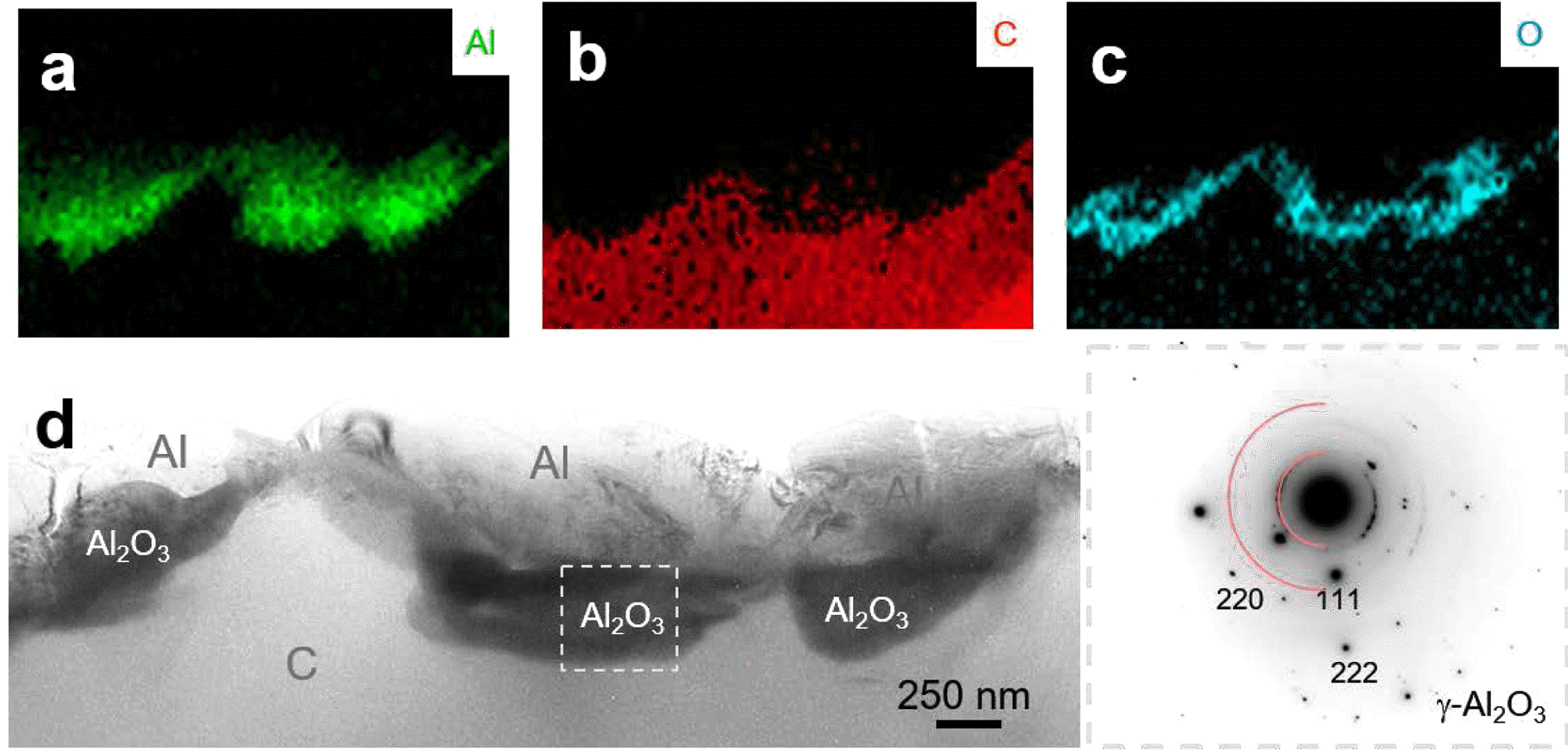
- 1,126 View
- 5 Download
- 1 Citations
-
 Abstract
Abstract
 PDF
PDF Spherical monosized pure aluminum (Al) particles are successfully fabricated by the pulsated orifice ejection method (POEM). The surface reaction between Al and the graphite crucible is investigated by analysing the microstructure and chemical composition of the materials. No significant chemical reaction occurs between Al and the graphite owing to the crystalline Al oxide (γ-Al2O3) layer generated in the initial state. The γ-Al2O3 layer is clearly observed in all regions between the Al particles and graphite via transmission electron microscopy and confirmed by the selected area diffraction pattern. The morphology of the γ-Al2O3 layer perfectly follows the surface morphology of the graphite crucible, which showed nanoscale roughness. This implies that molten Al could not directly contact graphite even though the surface of the crucible became rough to some extent. However, this passivation phenomenon allowed the successful fabrication of monosized pure Al particles. Therefore, POEM is a useful process at least to manufacture monosized pure Al particles.
-
Citations
Citations to this article as recorded by- Preparation of high sphericity monodisperse aluminum microspheres by pulsated orifice ejection method
Yongchang Guo, Can Li, Nan Deng, Hong Sun, Shaowei Feng, Ying Zhang, Xiaoqing Li, Enda Ci, Jianqiang Li
Materials Today Communications.2022; 30: 103110. CrossRef
- Preparation of high sphericity monodisperse aluminum microspheres by pulsated orifice ejection method
- [Korean]
- Effect of Na2CO3 Addition on Grain Growth Behavior and Solid-state Single Crystal Growth in the Na0.5Bi0.5TiO3-BaTiO3 System
- Kyoung-Seok Moon
- J Korean Powder Metall Inst. 2018;25(2):104-108. Published online April 1, 2018
- DOI: https://doi.org/10.4150/KPMI.2018.25.2.104
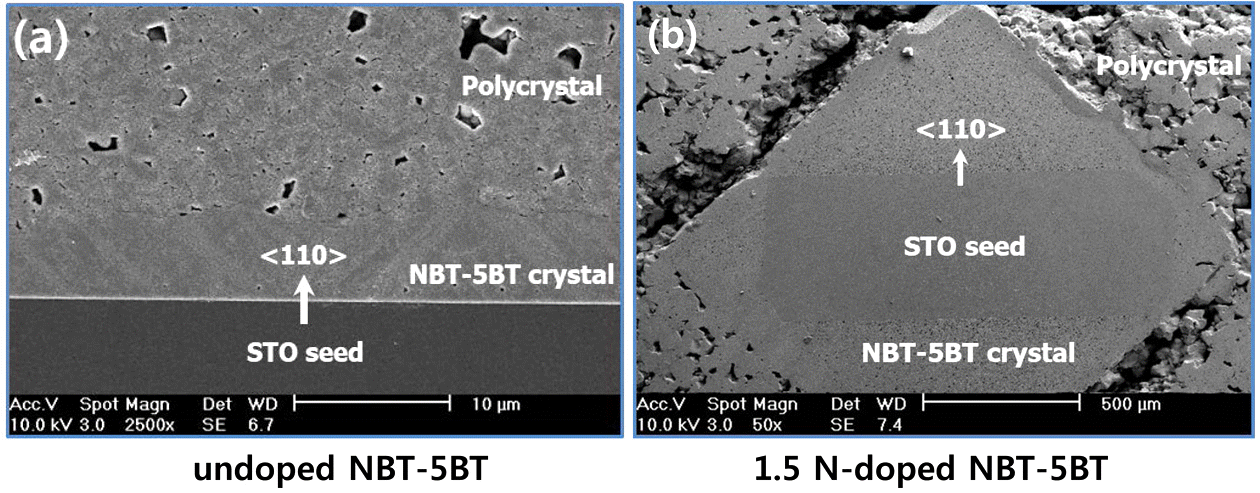
- 636 View
- 1 Download
- 2 Citations
-
 Abstract
Abstract
 PDF
PDF Grain-growth behavior in the 95Na1/2Bi1/2TiO3-5BaTiO3 (mole fraction, NBT-5BT) system has been investigated with the addition of Na2CO3. When Na2CO3 is added to NBT-5BT, the growth rate is higher than desired and grains are already impinging each other during the initial stage of sintering. The grain size decreases as the sintering temperature increases. With the addition of Na2CO3, a liquid phase infiltrates the interfaces between grains during sintering. The interface structure can be changed to be more faceted and the interface migration rate can increase due to fast material transport through the liquid phase. As the sintering temperature increases, the impingement of abnormal grains increases because the number of abnormal grains increases. Therefore, the average grain size of abnormal grains can be decreased as the temperature increases. The phenomenon can provide evidence that grain coarsening in NBT-5BT with addition of Na2CO3 is governed by the growth of facet planes, which would occur via mixed control.
-
Citations
Citations to this article as recorded by- Growth of single crystals in the (Na1/2Bi1/2)TiO3–(Sr1–xCax)TiO3 system by solid state crystal growth
Phan Gia Le, Huyen Tran Tran, Jong-Sook Lee, John G. Fisher, Hwang-Pill Kim, Wook Jo, Won-Jin Moon
Journal of Advanced Ceramics.2021; 10(5): 973. CrossRef - Sintering Behavior of M-type Sr-Hexaferrite by MnCO3 Addition
MinSeok Jeong, Changjae You, Jung Young Cho, Kyoung-Seok Moon
Journal of Korean Powder Metallurgy Institute.2020; 27(2): 126. CrossRef
- Growth of single crystals in the (Na1/2Bi1/2)TiO3–(Sr1–xCax)TiO3 system by solid state crystal growth
- [English]
- Solid-state sintering mechanism of blended elemental Ti-6Al-4V powders
- Youngmoo Kim, Young-Beom Song, Sung Ho Lee
- J Korean Powder Metall Inst. 2018;25(2):109-119. Published online April 1, 2018
- DOI: https://doi.org/10.4150/KPMI.2017.25.2.109
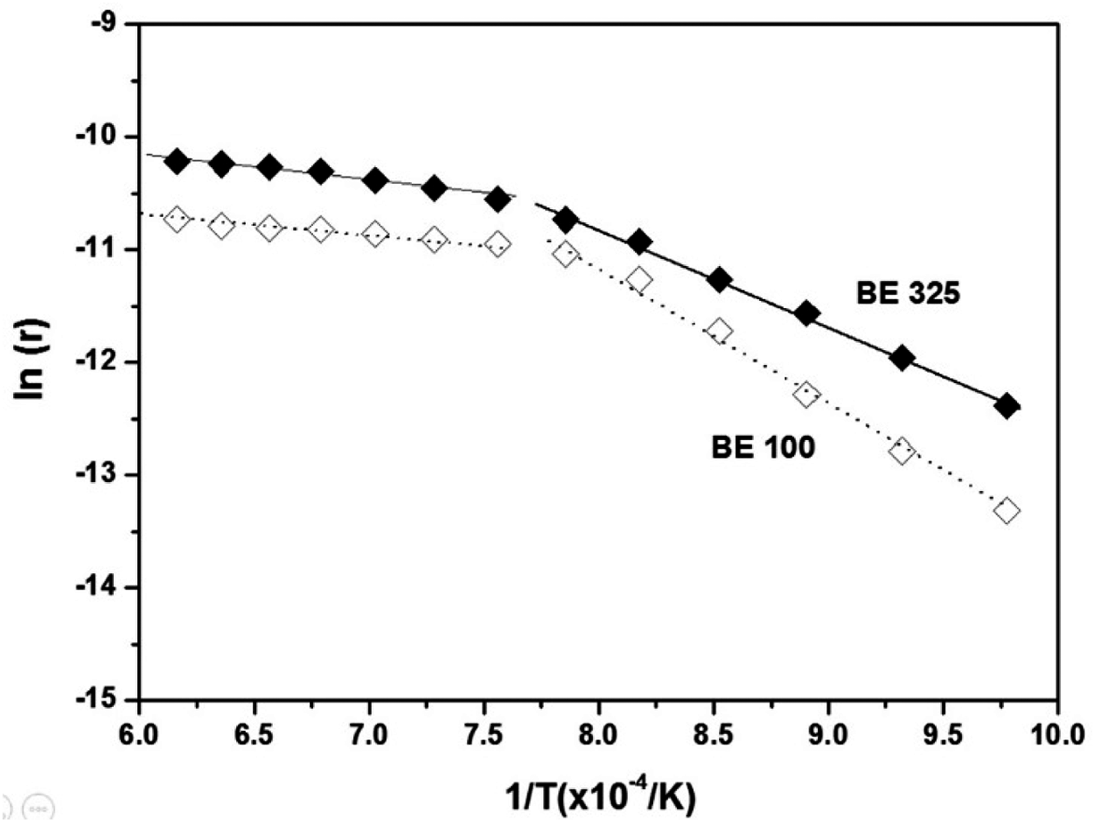
- 772 View
- 8 Download
-
 Abstract
Abstract
 PDF
PDF The objective of this study is to reveal the sintering mechanism of mixed Ti-6Al-4V powders considering the densification and the homogenization between Ti and Al/V particles. It is found that the addition of master alloy particles into Ti enhances densification by the migration of Al into the Ti matrix prior to the self-diffusion of Ti. However, as Ti particles become coarser, sintering of the powders appears to be retarded due to slower inter-diffusion of the particles due to the reduced surface energies of Ti. Such phenomena are confirmed by a series of dilatometry tests and microstructural analyses in respect to the sintering temperature. Furthermore, the results are also consistent with the predicted activation energies for sintering. The energies are found to have decreased from 299.35 to 135.48 kJ·mol-1 by adding the Al/V particles because the activation energy for the diffusion of Al in α-Ti (77 kJ·mol-1) is much lower than that of the self-diffusion of α-Ti. The coarser Ti powders increase the energies from 135.48 to 181.16 kJ·mol-1 because the specific surface areas of Ti decrease.
- [English]
- Synthesis of Boron Nitride Nanotubes via inductively Coupled thermal Plasma process Catalyzed by Solid-state ammonium Chloride
- Mi Se Chang, Young Gyun Nam, Sangsun Yang, Kyung Tae Kim, Ji Hun Yu, Yong-Jin Kim, Jae Won Jeong
- J Korean Powder Metall Inst. 2018;25(2):120-125. Published online April 1, 2018
- DOI: https://doi.org/10.4150/KPMI.2017.25.2.120
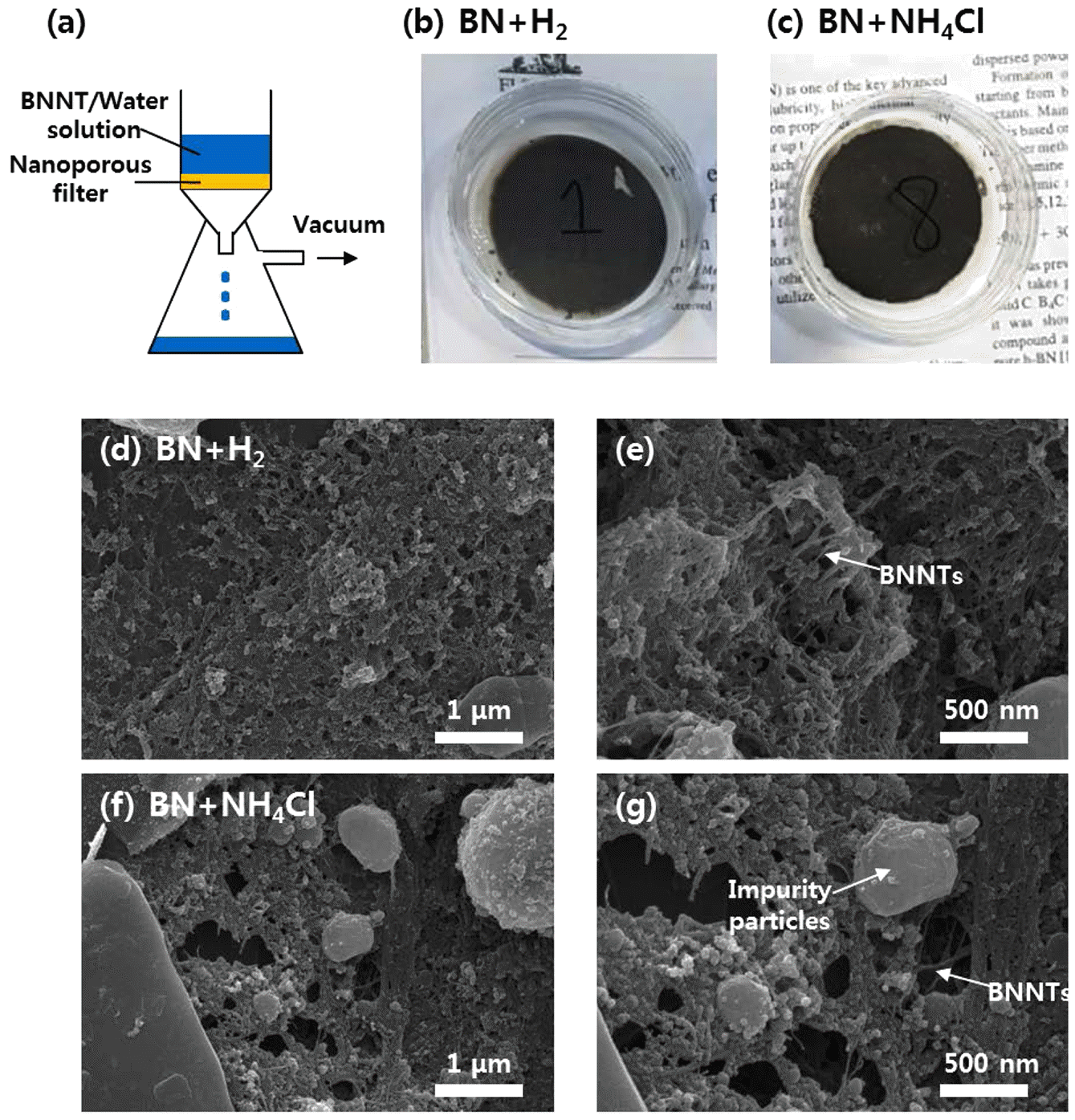
- 546 View
- 5 Download
-
 Abstract
Abstract
 PDF
PDF Boron nitride nanotubes (BNNTs) are receiving great attention because of their unusual material properties, such as high thermal conductivity, mechanical strength, and electrical resistance. However, high-throughput and highefficiency synthesis of BNNTs has been hindered due to the high boiling point of boron (~ 4000°C) and weak interaction between boron and nitrogen. Although, hydrogen-catalyzed plasma synthesis has shown potential for scalable synthesis of BNNTs, the direct use of H2 gas as a precursor material is not strongly recommended, as it is extremely flammable. In the present study, BNNTs have been synthesized using radio-frequency inductively coupled thermal plasma (RF-ITP) catalyzed by solid-state ammonium chloride (NH4Cl), a safe catalyst materials for BNNT synthesis. Similar to BNNTs synthesized from h-BN (hexagonal boron nitride) + H2, successful fabrication of BNNTs synthesized from h-BN+NH4Cl is confirmed by their sheet-like properties, FE-SEM images, and XRD analysis. In addition, improved dispersion properties in aqueous solution are found in BNNTs synthesized from h-BN +NH4Cl.
- [Korean]
- Effect of Milling Time and Addition of PCA on Austenite Stability of Fe-7%Mn Alloy
- Seung-Jin Oh, In-Jin Shon, Seok-Jae Lee
- J Korean Powder Metall Inst. 2018;25(2):126-131. Published online April 1, 2018
- DOI: https://doi.org/10.4150/KPMI.2018.25.2.126
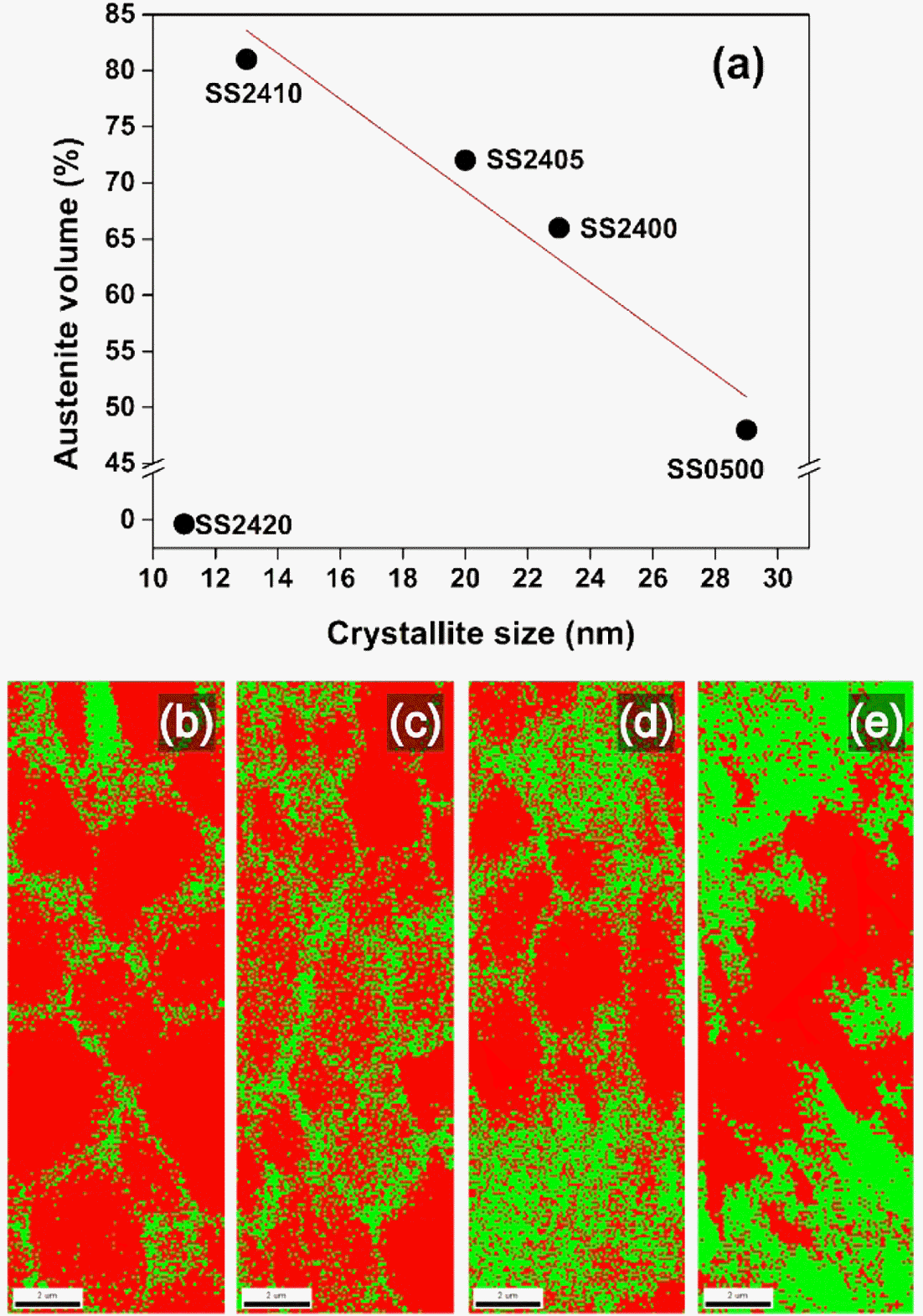
- 667 View
- 7 Download
- 5 Citations
-
 Abstract
Abstract
 PDF
PDF In the present study, we investigate the effects of milling time and the addition of a process control agent (PCA) on the austenite stability of a nanocrystalline Fe-7%Mn alloy by XRD analysis and micrograph observation. Nanocrystalline Fe-7%Mn alloys samples are successfully fabricated by spark plasma sintering. The crystallite size of ball-milled powder and the volume fraction of austenite in the sintered sample are calculated using XRD analysis. Changes in the shape and structure of alloyed powder according to milling conditions are observed through FE-SEM. It is found that the crystallite size is reduced with increasing milling time and amount of PCA addition due to the variation in the balance between the cold-welding and fracturing processes. As a result, the austenite stability increased, resulting in an exceptionally high volume fraction of austenite retained at room temperature.
-
Citations
Citations to this article as recorded by- Effects of mechanical milling on microstructure and mechanical properties of CrMnFeCoNi high-entropy alloy fabricated via spark plasma sintering
Seonghyun Park, Sang-Hwa Lee, Eunjoo Shin, Seok-Jae Lee, Jae-Gil Jung
Journal of Materials Research and Technology.2025; 39: 4854. CrossRef - Effect of Cooling Rate on Microstructure and Hardness during Solution Treatment and Aging Process of Ti-6Al-4V Alloy for Aerospace Components
Seongji Seo, Hojoon Choi, Geeyoung Lee, Kee-Ahn Lee, Jeongho Han, Minsu Jung
Journal of Materials Engineering and Performance.2021; 30(5): 3406. CrossRef - Development of Fe-Mn-based Hybrid Materials Containing Nano-scale Oxides by a Powder Metallurgical Route
Jonggyu Jeon, Jungjoon Kim, Hyunjoo Choi
Journal of Korean Powder Metallurgy Institute.2020; 27(3): 203. CrossRef - Austenite Stability of Sintered Fe-based Alloy
Seunggyu Choi, Namhyuk Seo, Junhyub Jun, Seung Bae Son, Seok-Jae Lee
Journal of Korean Powder Metallurgy Institute.2020; 27(5): 414. CrossRef - Austenite Stability of Nanocrystalline FeMnNiC Alloy
Seung-Jin Oh, Junhyub Jeon, In-Jin Shon, Seok-Jae Lee
Journal of Korean Powder Metallurgy Institute.2019; 26(5): 389. CrossRef
- Effects of mechanical milling on microstructure and mechanical properties of CrMnFeCoNi high-entropy alloy fabricated via spark plasma sintering
- [Korean]
- Synthesis and analysis CdSe/ZnS quantum dot with a Core/shell Continuous Synthesis System Using a Microfluidic Reactor
- Myung Hwan Hong, So Young Joo, Lee-Seung Kang, Chan Gi Lee
- J Korean Powder Metall Inst. 2018;25(2):132-136. Published online April 1, 2018
- DOI: https://doi.org/10.4150/KPMI.2018.25.2.132
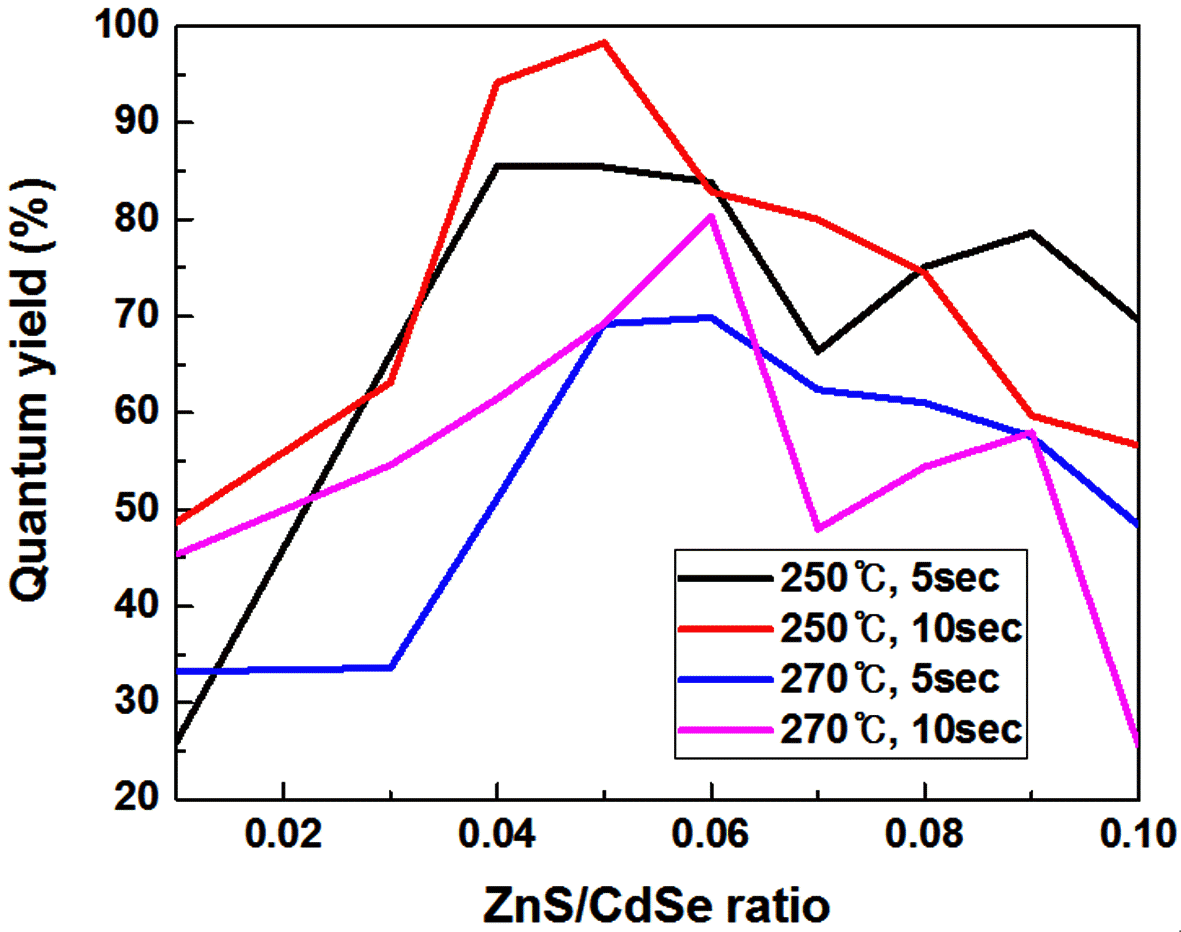
- 1,704 View
- 10 Download
-
 Abstract
Abstract
 PDF
PDF Core/shell CdSe/ZnS quantum dots (QDs) are synthesized by a microfluidic reactor-assisted continuous reactor system. Photoluminescence and absorbance of synthesized CdSe/ZnS core/shell QDs are investigated by fluorescence spectrophotometry and online UV-Vis spectrometry. Three reaction conditions, namely; the shell coating reaction temperature, the shell coating reaction time, and the ZnS/CdSe precursor volume ratio, are combined in the synthesis process. The quantum yield of the synthesized CdSe QDs is determined for each condition. CdSe/ZnS QDs with a higher quantum yield are obtained compared to the discontinuous microfluidic reactor synthesis system. The maximum quantum efficiency is 98.3% when the reaction temperature, reaction time, and ZnS/CdSe ratio are 270°C, 10 s, and 0.05, respectively. Obtained results indicate that a continuous synthesis of the Core/shell CdSe/ZnS QDs with a high quantum efficiency could be achieved by isolating the reaction from the external environment.
- [Korean]
- A study about sculpture characteristic of SKD61 tool steel fabricated by selective laser melting(SLM) process
- Jaecheol Yun, Jungho Choe, Ki-Bong Kim, Sangsun Yang, Dong-Yeol Yang, Yong-Jin Kim, Chang-Woo Lee, Chang-Woo Lee
- J Korean Powder Metall Inst. 2018;25(2):137-143. Published online April 1, 2018
- DOI: https://doi.org/10.4150/KPMI.2018.25.2.137
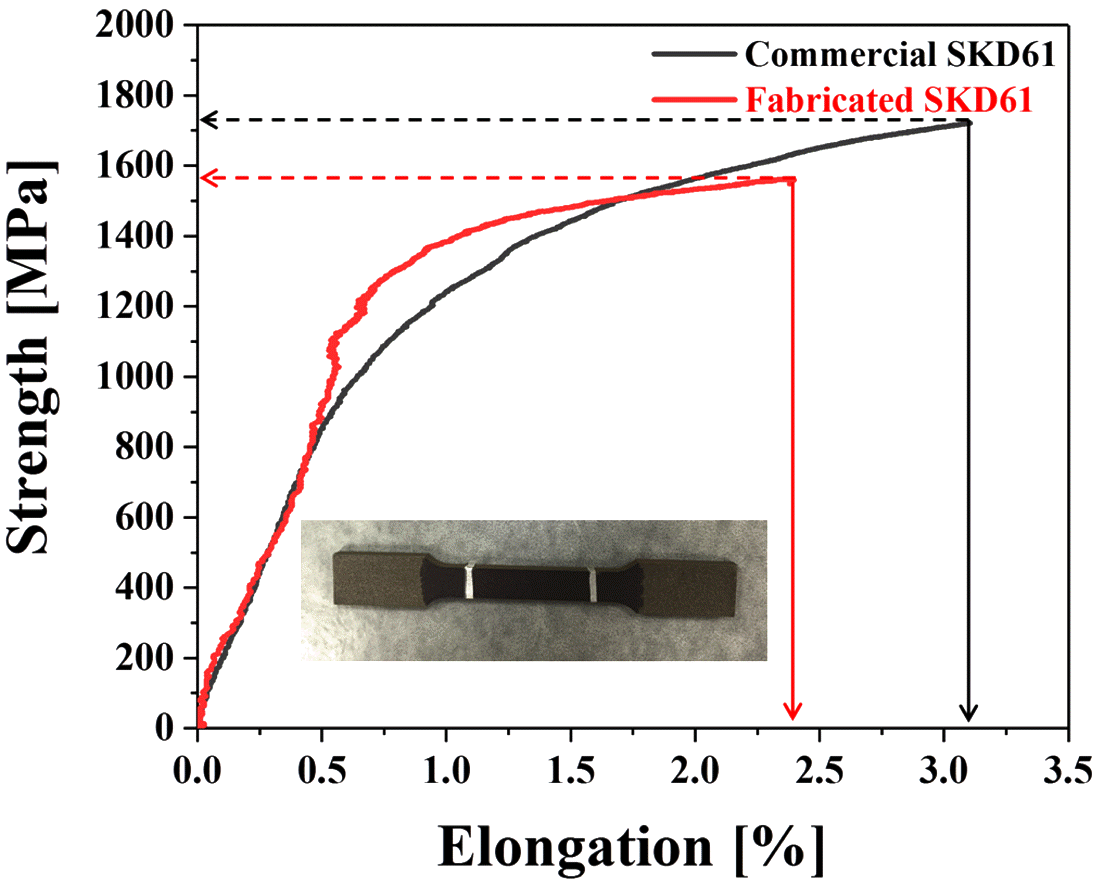
- 932 View
- 3 Download
- 1 Citations
-
 Abstract
Abstract
 PDF
PDF In this study, two types of SKD61 tool-steel samples are built by a selective laser melting (SLM) process using the different laser scan speeds. The characteristics of two kinds of SKD61 tool-steel powders used in the SLM process are evaluated. Commercial SKD61 tool-steel power has a flowability of 16.68 sec/50 g and its Hausner ratio is calculated to be 1.25 by apparent and tapped density. Also, the fabricated SKD61 tool steel powder fabricated by a gas atomization process has a flowability of 21.3 sec/50 g and its Hausner ratio is calculated to be 1.18. Therefore, we confirmed that the two powders used in this study have excellent flowability. Samples are fabricated to measure mechanical properties. The highest densities of the SKD61 tool-steel samples, fabricated under the same conditions, are 7.734 g/cm3 (using commercial SKD61 powder) and 7.652 g/cm3 (using fabricated SKD61 powder), measured with Archimedes method. Hardness is measured by Rockwell hardness testing equipment 5 times and the highest hardnesses of the samples are 54.56 HRC (commercial powder) and 52.62 HRC (fabricated powder). Also, the measured tensile strengths are approximately 1,721 MPa (commercial SKD61 powder) and 1,552 MPa (fabricated SKD61 powder), respectively.
-
Citations
Citations to this article as recorded by- Microstructural effects on the tensile and fracture behavior of selective laser melted H13 tool steel under varying conditions
Jungsub Lee, Jungho Choe, Junhyeok Park, Ji-Hun Yu, Sangshik Kim, Im Doo Jung, Hyokyung Sung
Materials Characterization.2019; 155: 109817. CrossRef
- Microstructural effects on the tensile and fracture behavior of selective laser melted H13 tool steel under varying conditions
- [Korean]
- Fabrication and Characterisitics of Al2O3-SiC Ceramic Composites for Electrostatic Discharge Safe Components
- Ha-Neul Kim, Hyun-Myung Oh, Young-Jo Park, Jae-Woong Ko, Hyun-Kwuon Lee
- J Korean Powder Metall Inst. 2018;25(2):144-150. Published online April 1, 2018
- DOI: https://doi.org/10.4150/KPMI.2018.25.2.144
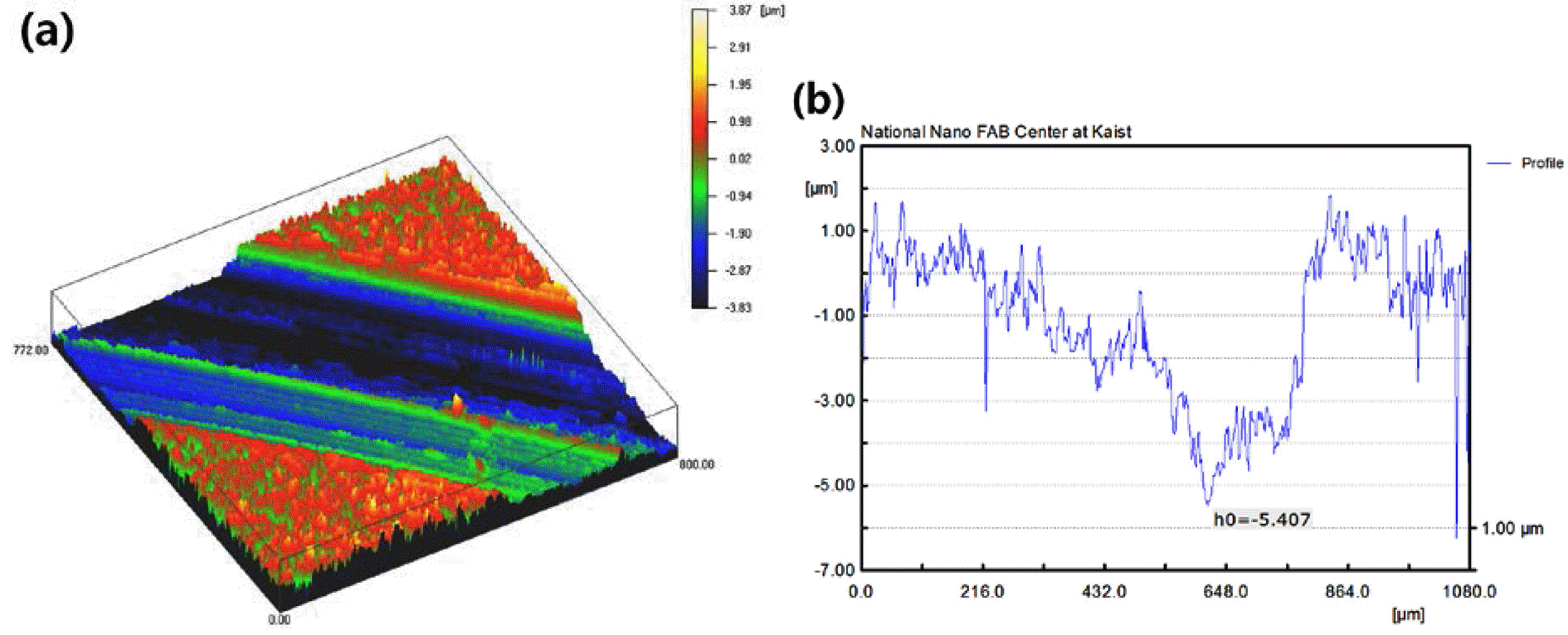
- 455 View
- 4 Download
-
 Abstract
Abstract
 PDF
PDF Al2O3-SiC ceramic composites are produced using pressureless sintering, and their plasma resistance, electrical resistance, and mechanical properties are evaluated to confirm their applicability as electrostatic-discharge-safe components for semiconductor devices. Through the addition of Mg and Y nitrate sintering aids, it is confirmed that even if SiC content exceeded 10%, complete densification is possible by pressureless sintering. By the uniform distribution of SiC, the total grain growth is suppressed to about 1 μm; thus an Al2O3-SiC sintered body with a high strength over 600 MPa is obtained. The optimum amount of SiC to satisfy all the desired properties of electrostaticdischarge-safe ceramic components is obtained by finding the correlation between the plasma resistance and the electrical resistivity as a function of SiC amount.
- [Korean]
- Preparation of Sintering Aid for Li7La3Zr2O12 Solid Electrolyte by Heat-treatment of Polymeric Precursors Containing Li and B
- Ran-Hee Shin, Sung-Soo Ryu
- J Korean Powder Metall Inst. 2018;25(2):151-157. Published online April 1, 2018
- DOI: https://doi.org/10.4150/KPMI.2018.25.2.151

- 797 View
- 1 Download
- 1 Citations
-
 Abstract
Abstract
 PDF
PDF In this study, the compound Li3BO3 (LBO) is intended to be prepared by a polymeric complex method as a sintering aid for the densification of Li7La3Zr2O12 (LLZ) solid electrolyte. A polymeric precursor containing Li and B is heat-treated in an air atmosphere at a temperature range between 600°C and 800°C. Instead of LBO, the compound Li2+xC1-xBxO3 (LCBO) is unexpectedly synthesized after a heat-treatment of 700°C. The effect of LCBO addition on sintering behavior and ion conductivity of LLZ is studied. It is found that the LCBO compound could lead to significant improvements in the densification and ionic conductivity of LLZ compared to pure LLZ. After sintering at 1100°C, the density of the LLZ-12wt%LBO composite is 3.72 g/cm3, with a high Li-ion conductivity of 1.18 × 10−4 Scm-1 at 28°C, while the pure LLZ specimen had a densify of 2.98 g/cm3 and Li-ion conductivity of 5.98 × 10−6 Scm-1.
-
Citations
Citations to this article as recorded by- Characterization of Li1.5Al0.5Ge1.5(PO4)3 Solid Electrolyte with an Added Sintering Aid
Hyun-Joon Lee, Liyu-Liu, Won-Jong Jeong, Seoung-Ki Lee, Bong-Ki Ryu
Electronic Materials Letters.2023; 19(1): 55. CrossRef
- Characterization of Li1.5Al0.5Ge1.5(PO4)3 Solid Electrolyte with an Added Sintering Aid
- [Korean]
- Fabrication of CNT dispersed Cu matrix composites by wet mixing and spark plasma sintering process
- Seungchan Cho, Ilguk Jo, Sang-Bok Lee, Sang-Kwan Lee, Moonhee Choi, Jehong Park, Hansang Kwon, Yangdo Kim
- J Korean Powder Metall Inst. 2018;25(2):158-164. Published online April 1, 2018
- DOI: https://doi.org/10.4150/KPMI.2018.25.2.158

- 842 View
- 17 Download
- 1 Citations
-
 Abstract
Abstract
 PDF
PDF Multi-walled carbon nanotube (MWCNT)–copper (Cu) composites are successfully fabricated by a combination of a binder-free wet mixing and spark plasma sintering (SPS) process. The SPS is performed under various conditions to investigate optimized processing conditions for minimizing the structural defects of CNTs and densifying the MWCNT–Cu composites. The electrical conductivities of MWCNT–Cu composites are slightly increased for compositions containing up to 1 vol.% CNT and remain above the value for sintered Cu up to 2 vol.% CNT. Uniformly dispersed CNTs in the Cu matrix with clean interfaces between the treated MWCNT and Cu leading to effective electrical transfer from the treated MWCNT to the Cu is believed to be the origin of the improved electrical conductivity of the treated MWCNT–Cu composites. The results indicate the possibility of exploiting CNTs as a contributing reinforcement phase for improving the electrical conductivity and mechanical properties in the Cu matrix composites.
-
Citations
Citations to this article as recorded by- Proposing Machine Learning Models Suitable for Predicting Open Data Utilization
Junyoung Jeong, Keuntae Cho
Sustainability.2024; 16(14): 5880. CrossRef
- Proposing Machine Learning Models Suitable for Predicting Open Data Utilization
- [Korean]
- Trends and Implications of International Standardization for Rare Earths
- Sardar Farhat Abbas, Sang-Hyun lee, Bin Lee, Bum-Sung Kim, Taek-Soo Kim
- J Korean Powder Metall Inst. 2018;25(2):165-169. Published online April 1, 2018
- DOI: https://doi.org/10.4150/KPMI.2018.25.2.165
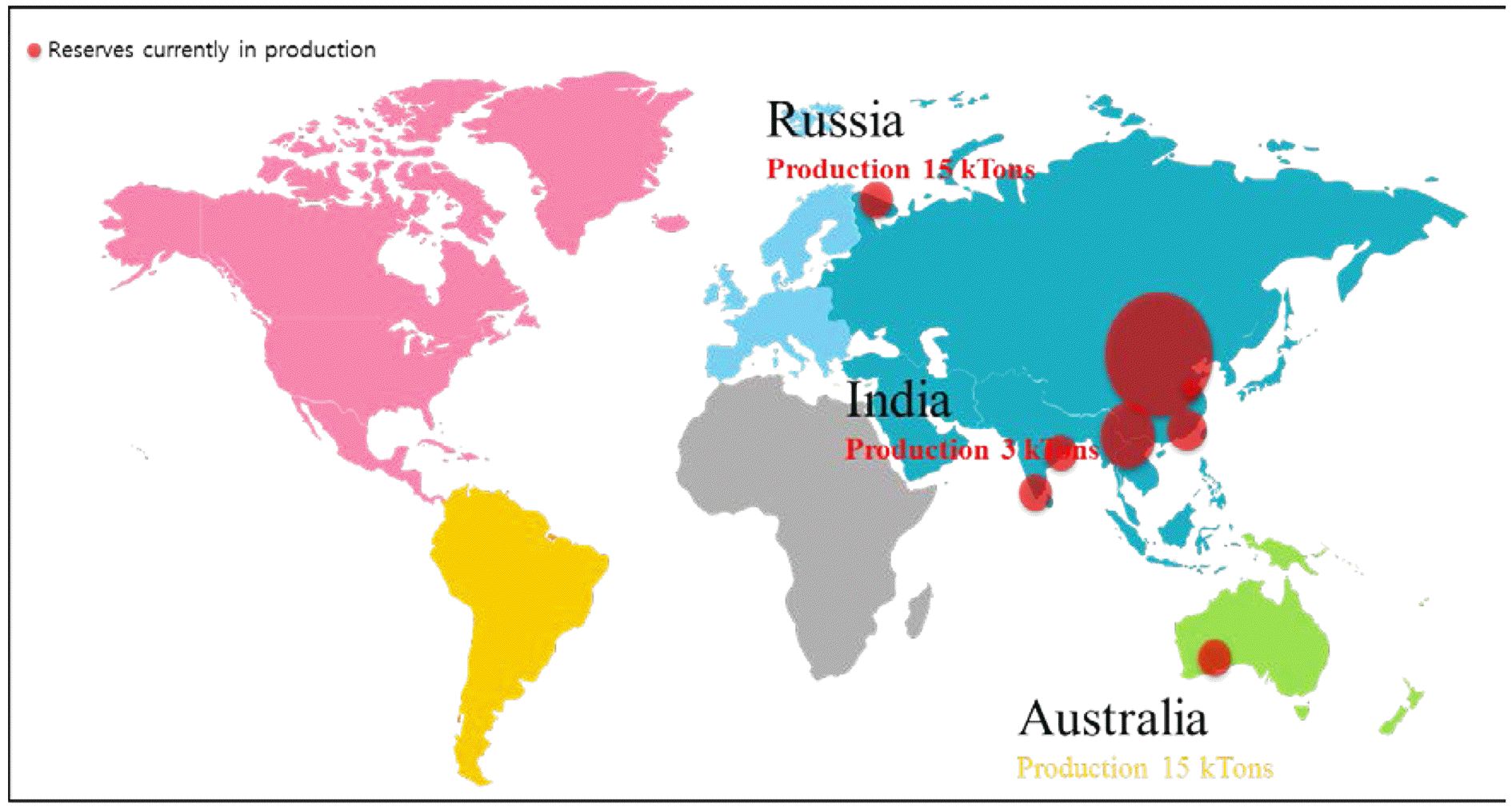
- 885 View
- 5 Download
- 2 Citations
-
 Abstract
Abstract
 PDF
PDF Rare earth elements (REEs) are considered to be vital to modern industry due to their important roles in applications such as permanent magnets, automobile production, displays, and many more. The imbalance between demand and supply of REEs can be solved by recycling processes. Regarding the needs of industry and society, the International Organization for Standardization, Technical Committee 298 (ISO/TC298) Rare Earths has been recently launched for developing international standards on rare earth elements. In accordance with the suggestion of its constituents, it is tentatively working to develop the appropriate standards under five working groups (WG) on terms and definitions (WG1), element recycling (WG2), environmental stewardship (WG3), packaging, labelling, marking, transport, and storage (WG4), and testing analysis (WG5). The scope and structure of ISO/TC298 on the topic of rare earths is discussed in this document.
-
Citations
Citations to this article as recorded by- Synthesis and magnetic properties of Sm2Co17 particles using salt-assisted spray pyrolysis and a reduction-diffusion process
Tae-Yeon Hwang, Jimin Lee, Min Kyu Kang, Gyutae Lee, Jongryoul Kim, Yong-Ho Choa
Applied Surface Science.2019; 475: 986. CrossRef - Worker Safety in the Rare Earth Elements Recycling Process From the Review of Toxicity and Issues
Seo-Ho Shin, Hyun-Ock Kim, Kyung-Taek Rim
Safety and Health at Work.2019; 10(4): 409. CrossRef
- Synthesis and magnetic properties of Sm2Co17 particles using salt-assisted spray pyrolysis and a reduction-diffusion process
- [Korean]
- Technology Trend of Luminescent Nanomaterials
- Hyewon Jeong, Jae Sung Son
- J Korean Powder Metall Inst. 2018;25(2):170-177. Published online April 1, 2018
- DOI: https://doi.org/10.4150/KPMI.2018.25.2.170
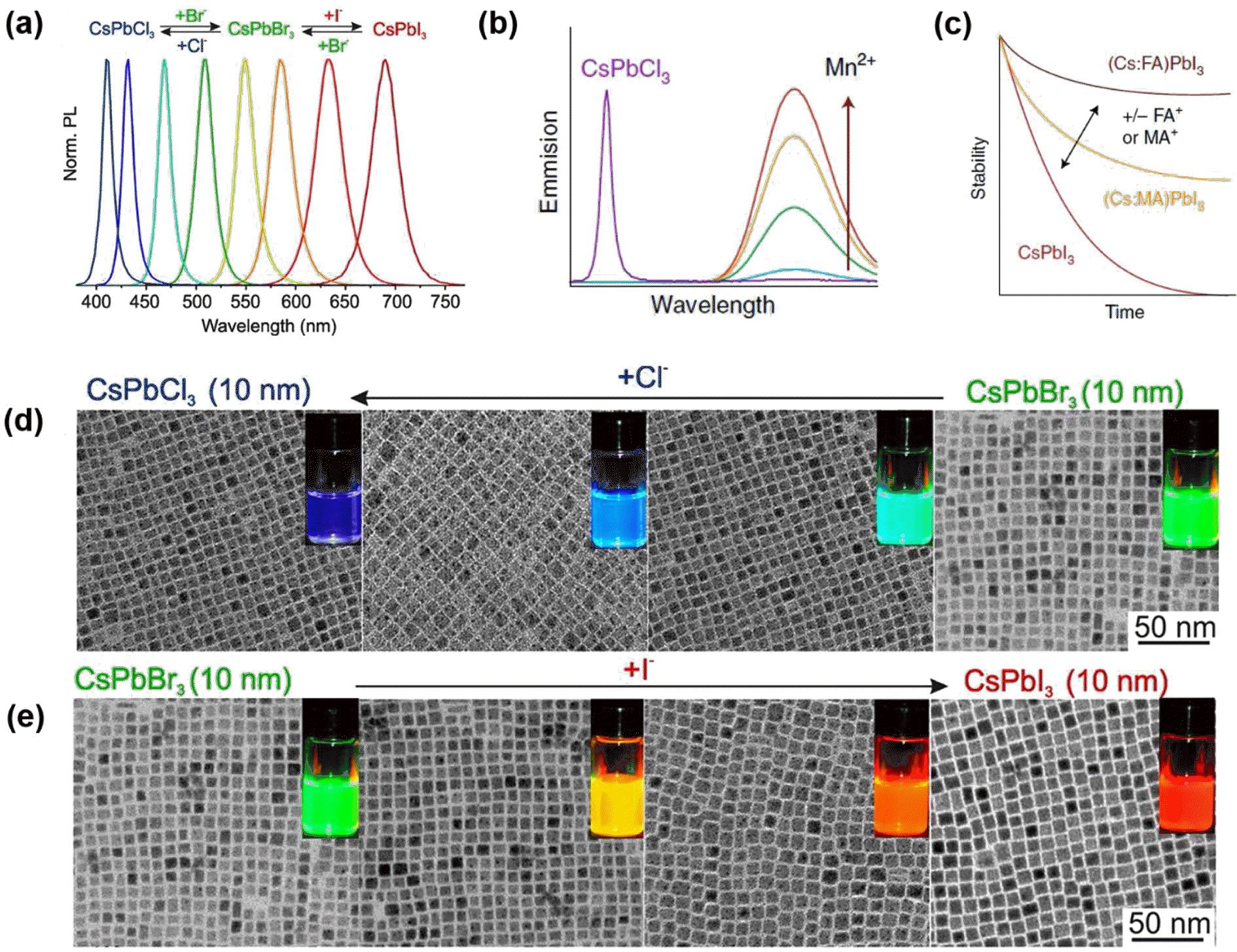
- 932 View
- 2 Download
- 1 Citations
-
 Abstract
Abstract
 PDF
PDF Colloidally synthesized luminescent nanocrystals (NCs) have attracted tremendous attention due to their unique nanoscale optical and electronic properties. The emission properties of these NCs can be precisely tuned by controlling their size, shape, and composition as well as by introducing appropriate dopant impurities. Nowadays, these NCs are actively utilized for various applications such as optoelectronic devices including light emitting diodes (LEDs), lasers, and solar cells, and bio-medical applications such as imaging agents and bio-sensors. In this review, we classify luminescent nanomaterials into quantum dots (QDs), upconversion nanoparticles (UCNPs), and perovskite NCs and present their intrinsic emission mechanism. Furthermore, the recently emerging issues of efficiency, toxicity, and durability in these materials are discussed for better understanding of industry demands. As well, the future outlook will be offered for researchers to guide the direction of future research.
-
Citations
Citations to this article as recorded by- A Structural Relationship between University Dance Students’ Emotional Regulation, Emotion Response, and Engagement in Classes
Jinhee Gong
The Journal of Korean Institute of Information Technology.2020; 18(4): 121. CrossRef
- A Structural Relationship between University Dance Students’ Emotional Regulation, Emotion Response, and Engagement in Classes
TOP
 KPMI
KPMI




 First
First Prev
Prev


